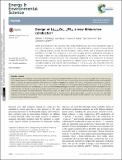Design of Li[subscript 1+2x]Zn[subscript 1−x]PS[subscript 4], a New Lithium Ion Conductor
Author(s)
Miara, Lincoln J.; Richards, William D; Wang, Yan; Kim, Jae Chul; Ceder, Gerbrand
DownloadDesign of Li1.pdf (1.799Mb)
PUBLISHER_CC
Publisher with Creative Commons License
Creative Commons Attribution
Terms of use
Metadata
Show full item recordAbstract
Recent theoretical work has uncovered that a body-centered-cubic (bcc) anion arrangement leads to high ionic conductivity in a number of fast lithium-ion conducting materials. Using this structural feature as a screening criterion, we find that the I[4 with combining macron] material LiZnPS[subscript 4] contains such a framework and has the potential for very high ionic conductivity. In this work, we apply ab initio computational techniques to investigate in detail the ionic conductivity and defect properties of this material. We find that while the stoichiometric structure has poor ionic conductivity, engineering of its composition to introduce interstitial lithium defects is able to exploit the low migration barrier of the bcc anion framework. Our calculations predict a solid-solution regime extending to x = 0.5 in Li[subscript 1+2x]Zn[subscript 1−x]PS[subscript 4], and yield a new ionic conductor with exceptionally high lithium-ion conductivity, potentially exceeding 50 mS cm[supercript −1] at room temperature.
Date issued
2016-09Department
Massachusetts Institute of Technology. Department of Materials Science and EngineeringJournal
Energy and Environmental Science
Publisher
Royal Society of Chemistry
Citation
Richards, William D.; Wang, Yan; Miara, Lincoln J.; Kim, Jae Chul and Ceder, Gerbrand. “Design of Li[subscript 1+2x]Zn[subscript 1−x]PS[subscript 4], a New Lithium Ion Conductor.” Energy and Environmental Science 9, no. 10 (September 2016): 3272–3278 © 2016 The Royal Society of Chemistry
Version: Final published version
ISSN
1754-5692
1754-5706